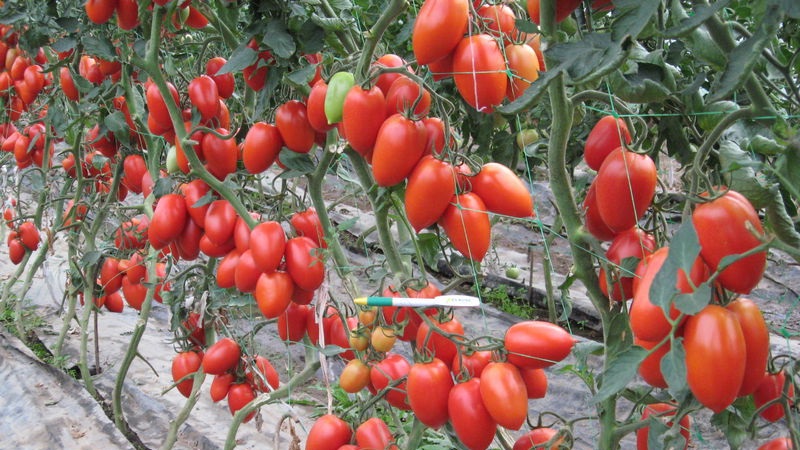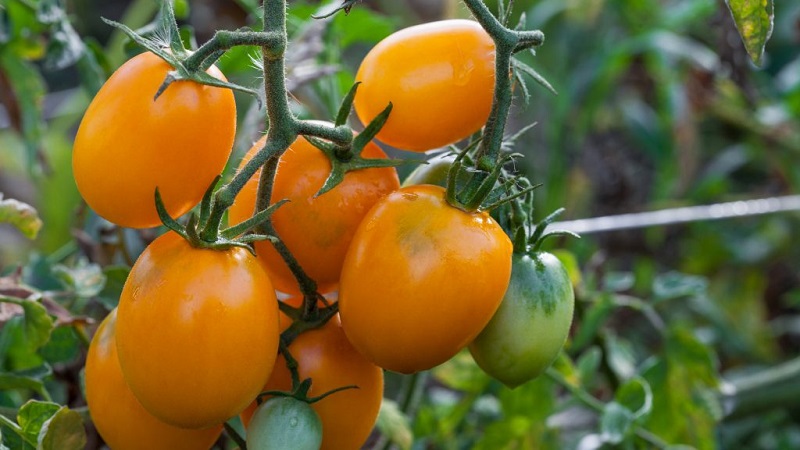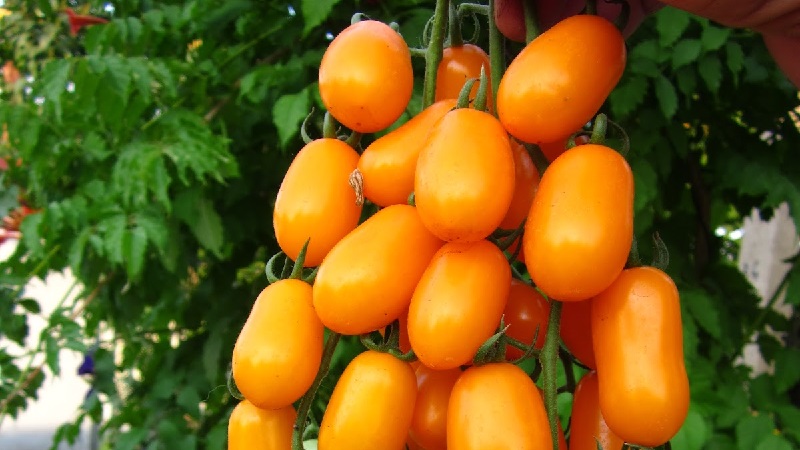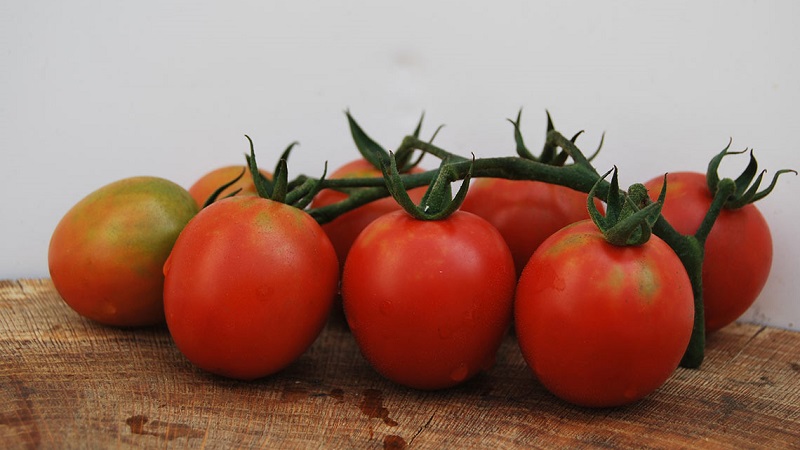Unusual Tomato Cream and how to care for it
Tomatoes Cream got their name from their elliptical fruit. Such varieties were bred for a long time, and they have gained good fame among vegetable growers. These nightshades are grown for whole-fruit canning, fresh consumption, freezing and drying.
Plum tomatoes are compared with the cherry variety, but the difference between Cream is that the variety has a higher yield and unpretentiousness. This species is able to grow both an experienced gardener and a novice summer resident.
The content of the article
Characteristics and description of the variety, yield indicators
Cream has a wide variety of varieties: early maturing and late, and undersized and tall, up to indeterminate vines. Most of the subspecies are intended for open beds, but some of them grow better in greenhouses. This variety is known all over the world for its extraordinary oblong shape, reminiscent of a plum.
Tomatoes Cream is a high-yielding tomato variety that has a variety of pulp colors. Depending on the variety, the fruits are bright red, orange, violet-blue and other colors. Housewives prefer pink cream, they say that such tomatoes are the most delicious and tender.
Fruit weight varies between 50-120 g. From one square meter of tomato planting, 7 to 10 kg of fruits are harvested. The vegetable has a strong skin and dense pulp that does not crack during storage and transportation. The fruit contains few grains.
There are more than a dozen varieties of Cream. Tomatoes ripen in the same time frame as regular tomatoes:
- early - up to 90 days;
- medium - up to 120 days;
- late ripening - over 120 days.
Also, the fruits contain a small amount of liquid, which is why they are not used for making juices. Low-calorie tomatoes, 100 g contains 22 kcal. The branchiness of the bushes is medium. Leaves are dark green in color, inflorescences are light yellow. The height of the average bush is 40-70 cm, but some subspecies reach 1.5-2.5 m.
On a note. Tomatoes Small cream is successfully grown even on a veranda, windowsill or balcony.

Advantages and disadvantages of Cream
Advantages of Cream and its varieties:
- the variety gives a bountiful harvest;
- all cream is beautiful to look at;
- tomatoes are stored for a long time and practically do not deteriorate;
- tomatoes have a sweet delicate taste;
- tomatoes are easy to grow;
- fruits are easy to transport;
- versatile in use;
- the variety is resistant to pests and diseases.
There were practically no flaws in the variety, except for the need for regular feeding and watering.
Most popular varieties
Let's consider the most popular varieties of Cream.
Moscow Cream... The variety is early maturing, the harvest is harvested 100-110 days after planting the seeds. The crop is intended for cultivation both in greenhouse conditions and in the open field. It is famous for its high yield and strong immunity.
Royal Cream Is an early ripening variety. It is usually grown in open ground under a film. The bush grows up to 60-75 cm, but it gives a bountiful harvest. Royal tomatoes have an elongated cylindrical shape and have a pleasant smell.
Yellow Cream... Tomatoes are appreciated for their simplicity in care and excellent taste. The bush grows up to 1.5 m and needs a garter. On the garden bed, they are grown only in warm areas with early spring and hot summer.With this cultivation, additional watering is needed. This variety is early maturing, the fruits are harvested already 90 days after planting.
Argentinean Cream red. The variety is fruitful, mid-season. The height of the bush reaches 2 m. Beautiful fruits have excellent taste. Fruit weight is small - only up to 80 g. Tomatoes are ideal for preservation. In addition, the culture has a stable immunity to diseases and does not suffer from pests.
Brazilian Cream... A culture with such an exotic name grows up to 1.5 m. Small fruits of bright red color weigh up to 60-70 g, are pear-shaped. Tomatoes taste sweet. The variety is grown only in a greenhouse, but the scope is not limited.
Honey Cream... This variety has strong immunity and good disease resistance. Tomatoes are unpretentious in care, great for growing by beginner gardeners. The fruits are bright red in color and have a wonderful sweet taste. Fruit weight rarely exceeds 50-70 g.
Tomato Black Plum Is a mid-season variety that is intended for outdoor cultivation. The bushes reach 2.5 m. The culture bears fruit in 110-120 days. The color of tomatoes is not always black, rather, it varies from dark red to purple-blue.
Chio-chio-san... A tall, branchy subspecies that looks like a tomato tree. It is grown both outdoors and in greenhouse conditions. A distinctive feature of the variety is large clusters with an abundance of pink fruits.
Sun Bunny F1... The hybrid is early maturing and tall. Recommended for cultivation in greenhouse conditions. The bush has small clusters with bright yellow fruits of a delicate sweet taste, and has a strong immunity to diseases and pests.
Cream giant... The shrub grows tall and produces a large bountiful crop of tomatoes. The fruits ripen 115 days after sowing the seeds, the average weight of one vegetable is 100-120 g. The fleshy tomato has a sour taste, is stored for a long time and tolerates transportation well.
Watercolor... The Siberian variety belongs to the early maturing (the crop is harvested three months after the sowing of the seed). Watercolors do not need garter and pinching. Red tomatoes have an oval shape and an average weight of up to 120 g. The high-yielding variety is resistant to septoria and rot.
For your information. In medicine, tomatoes are often used as a cure for burns and wounds, as their pulp contains phytoncides that prevent the development of infections.

How to Grow Cream
Sowing of seeds is carried out in late winter and early spring (February-March). The terms are set depending on the variety itself and the time of growing seedlings (from 45 to 75 days).
What should be the soil
The soil for growing tomatoes should be slightly acidic or neutral. If the acidity of the soil is increased, dolomite flour (crushed lime, wood ash) is introduced into it.
The plot is not suitable for tomatoes if it was grown there last year pepper, eggplant, physalis. Otherwise, the rules of crop rotation will be violated.
To get a bountiful harvest, the soil is fertilized with organic matter. To do this, in the fall, you should scatter a rotted mullein or compost (a bucket for one square meter). Phosphorus-potassium dressings are also important (20 g per sq. M).
At the beginning of spring, it is recommended to enrich the soil with nitrogen fertilizers, which have a beneficial effect on the growth of young shoots.

Sowing rules
Before sowing, the seeds must be warmed up by placing them in a warm place (two days at + 30 ° C, then three days at + 50 ° C) and soak for 30 minutes in a slightly pink solution of potassium permanganate. Soil for tomatoes is disinfected by spraying with EM-Baikal.
Pots or wooden boxes with a height of at least 10 cm are suitable as containers. Peat tablets are also used. The depth of planting seeds in wet soil is 1 cm. After planting the material, cover the container with foil.
Suitable conditions for seedlings:
- for seed germination, set the temperature to about +25 ° С;
- in a week we remove the film and put the seedlings in a well-lit place;
- we lower the temperature regime: at night up to + 8 ... + 10 ° С, in the daytime + 10 ... + 15 ° С;
- after 7 days we increase the temperature: at night up to + 14 ... + 16 ° С, during the day + 20 ... + 25 ° С.
The room with seedlings must be ventilated, but at the same time, drafts and a critical drop in temperature must be avoided.

Transplanting tomatoes into open ground
Seedlings are planted during the period when a positive night temperature is established (late May-early June). For one square. m have 3-5 plants. The bush will get stronger by that time, and will have 7-8 leaves.
The culture is transplanted into moistened wells at right angles to the ground. The soil is compacted over the roots. A fourth or even a third of the stem is placed in the ground. If the region is windy and is characterized by heavy rainfall, it is advisable to install a small peg for each plant, which will serve as a support for it.
Post-transplant Cream Care
The rules for caring for Cream are practically no different from the agricultural technology of tomatoes in general.
For the normal cultivation of tomatoes, the garden must be weeded regularly. Weed removal is done to prevent planting from thickening, which provokes fungal diseases and attracts pests. In addition, weeds are dangerous in that they absorb all the moisture and useful minerals in the soil, thereby robbing tomatoes and preventing them from growing and developing normally.
Loosening is carried out for better development of the root system, which saturates the soil with oxygen and prevents moisture stagnation.
As a rule, both procedures (weeding and loosening) are combined. The bushes are huddled to increase their resistance. This is especially important for tall subspecies and windy environments.
The garden bed is watered 2-3 times a week (6-7 liters of cold water per sq. M). In stagnant hot weather, the amount of liquid is increased to 10 liters per square meter. m. Soil moistening is carried out either in the morning or in the evening. The main thing is not in open sunlight.
For crops, it is better to use a drip irrigation system. Sprinkling provokes the fall of inflorescences. Conventional irrigation with a hose is carried out at the root with a low pressure.
On a note. The simplest drip system is made from ordinary plastic bottles. Cut off the bottom, make several holes in the cap, dig in the bottle with the neck down near each bush and fill it with water. The advantage of the system is that you can replenish moisture reserves at any time of the day and in any weather.
For the entire growing season, the culture is fed at least twice. The first fertilization is carried out 3 weeks after planting the seedlings in open ground, the second - after another 3 weeks, during the onset of intensive fruit formation.
A combination of the following components is used to prepare the nutritional formula:
- potassium (15 g);
- nitrogen fertilizers (25 g);
- phosphorus substances (40 g);
- water (10 l).
Mineral dressings are dry sealed in the aisles.
As the bush forms, stepsons are removed once a week. In the second half of August, pinch the tops so that the fruits themselves develop better. The lower leaves take away the strength of the plant, they also need to be cut off.
Some vegetable growers make mistakes when growing tomatoes. Here are the most common ones:
- tomatoes are planted in the same place every year;
- seedlings are planted tightly - if the seedlings are planted close to each other, they cannot develop normally;
- violate the irrigation regime (both drought and abundance of moisture are dangerous for tomatoes);
- too much fertilizer is introduced, overfeeding the plants, which leads to a waste of resources for the growth of the tops, and not for the setting of fruits.
For your information. It is better to plant tomatoes of different ripening periods. This way, you will get a continuous tomato harvest from June to October.

Prevention of diseases and pests
The variety has strong immunity. Culture is rarely exposed to disease fusarium, wilting, late blight and rot... However, young plants are afraid of aphids and other insects. They get rid of pests with drugs "Aktofit" or "Operkot". To remove the Colorado potato beetle, apply "Prestige" or "Regent".
Attention! Many varieties of Cream are resistant to most diseases, but are prone to late blight and need to be treated with drugs. Information about the susceptibility of the crop to certain diseases should be indicated on the seed packaging. In this regard, hybrids are the most stable.

Reviews of tomatoes Cream
Cream has gained great popularity among gardeners. Most summer residents believe that these tomatoes are worthy of attention. However, there are those who do not like tomatoes. Consider some reviews about Tomato Cream.
Galina: “I love Cream. We use these tomatoes in any form: we ferment, preserve, freeze and even dry. I am not even talking about fresh consumption - my grandchildren pluck it straight from the garden. Favorite varieties of my whole family are Honey and Yellow Cream. They are the sweetest and brightest. I recommend these species for planting! "
Ivan: “I don’t like this variety. In my opinion, the Cream is rather dry and requires a lot of attention. I prefer to grow and use classic varieties with large juicy fruits for preservation and cooking. "
Tatyana: “I have been growing cream for a long time, for about 10 years already. This variety was once recommended to me by a consultant in an agricultural store, when I decided to diversify my beds with new types of tomatoes. Over the years, I have tried almost all subspecies, I especially liked the Royal Cream for a bountiful harvest, pleasant aroma and the opportunity to feast on my favorite tomato at a time when others are just beginning to ripen. The cream is fleshy, strong, has a long shelf life and is easy to transport. I plant the seeds immediately in the ground, cover them with foil and do not bother myself with unnecessary manipulations with the seedlings. I like to grow Cream because it is not capricious in its care and is not afraid of pests. "

Conclusion
Summer residents love the tomato Cream for its aesthetic and taste qualities, as well as ease of care and practicality. The variety has many subspecies, each of which has its own characteristics. The versatility of Cream allows you to choose a subspecies for every taste and for any climate. The variety perfectly adapted to the weather conditions of our latitudes, which makes it even more attractive for novice agronomists.
Details on growing Honey Cream, all the pros and cons of this variety, you will learn further, in the video: